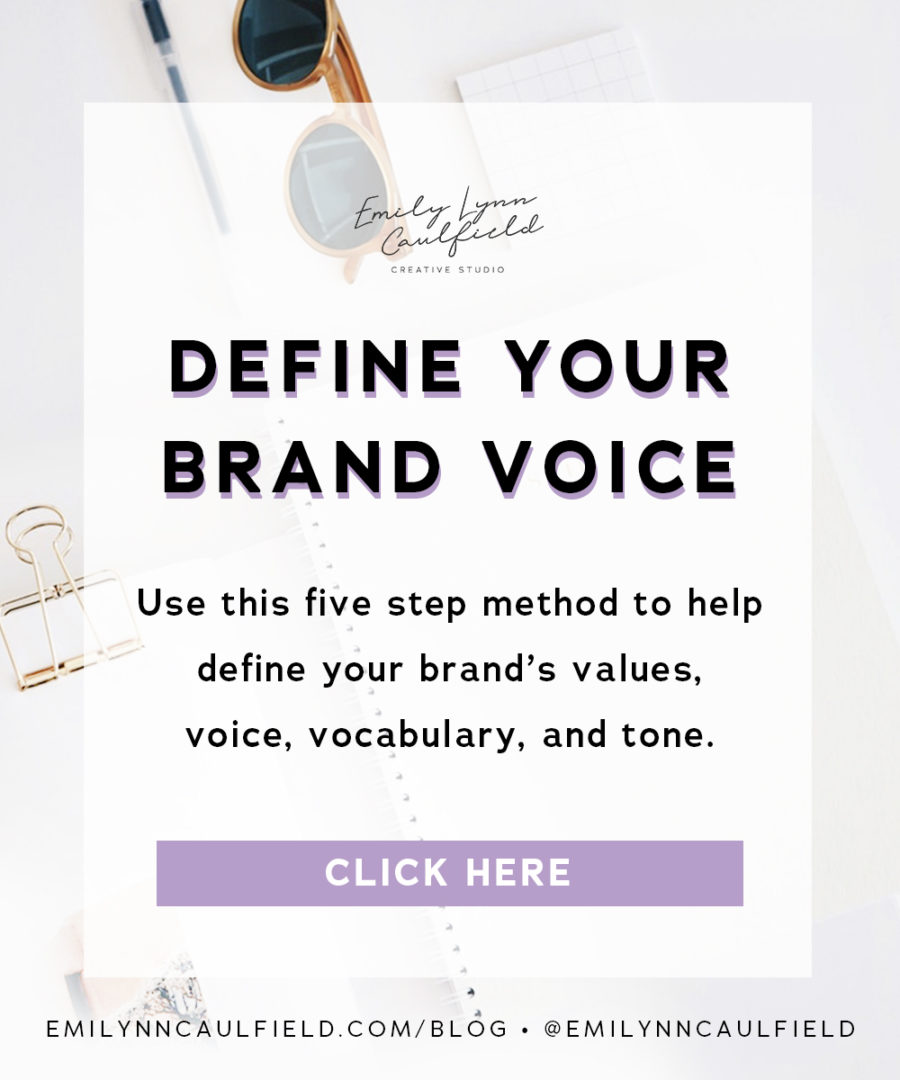Define Your Brand Voice & Vocab
What is a Brand Voice?
Your Brand Voice is a powerful tool that becomes a part of your visual identity. It is the vocabulary, language, personality, and tone that defines your brand. Defining your brand voice will help you engage with your clients, create desire, and call your ideal customers to action. Each brand is unique and created for a specific purpose with a specific set of values. What’s your brand’s purpose? What does your brand value?
Why is it important?
Your brand voice is important because it allows you to develop brand recognition with consumers, which requires consistency & repetition. If your brand’s voice is constantly changing, it’s harder for your audience to connect with you and know what you have to offer.

How to Define Your Own Brand’s Voice
It might be overwhelming at first, but it doesn’t have to be hard! You can easily define your brand’s voice by following along these 5 steps.
Step One: Identify Your Brand’s Values & Purpose
What values does your brand stand for? If you have a mission statement in place, analyze each & every word. Ask yourself these questions:
- What do you want to be known for?
- What do you have to share or offer?
- How are you different from your competitors?
- What characteristics do you value?
For example, our brand values honesty, continued learning, passion, collaboration, empowerment, and quality.
Check out this post for more inspiration: 18 Core Company Values That Will Shape Your Culture & Inspire Your Employees
Step Two: Review Your Current Content & Messaging
You may already have an existing voice in place, or at least the outline to one. To get a better understanding of your current content, review the following:
- About Me page
- Website Copy
- Social Media Posts
- Replies to your audience
- Blog Posts
- Videos / Livestreams
- Email Marketing
- How You Respond to Customers
After reviewing your copy, do you feel that your current voice fits your brand’s purpose? How does the way you sound now, compare to how you’d like to sound?
Act as if YOU are your ideal client, are you reading what you need to? What impressions will they get from reading your website copy? Or your social media captions?

Step Three: Identify Your Audience
Use Google Analytics or your social media’s insights page and analyze your most popular pieces.
Identify Characteristics by asking yourself: “What is my audience writing? Reading? Interested in?”
These findings will help you learn more about the audience that you’re serving and what kind of content they’re interested in.
Step Four: Consider Your Words
How you write and speak to your audience, matters. Let’s try an exercise: Find three words that describe your brand, and write them down in this Brand Voice Chart. When you’ve found three that describe the look and feel of your brand, look up their definitions and add it to the chart.
Here’s a list of Traits to help you brainstorm.
How would you like to use these words? In your brand voice chart, write the do’s & do not’s for each word and how they will be used for your brand. Think about the message you want to communicate. When using those three words, how should they sound?
Ask yourself these questions to understand your brand voice better:
- Does your brand swear?
- Is your brand more formal or casual when speaking to clients?
- How would you answer the phone or an email?
Here’s an example of our own voice chart.

Step Five: Create & Enforce Consistent Brand Guidelines
To make sure your brand’s message stays clear and consistent, it’s helpful to have guidelines in place. All copy, imagery, and designs, should feel cohesive and purposeful.
If you aren’t the only one writing copy for your business, having guidelines for your employees to follow is a necessity. It ensures consistency across all platforms and acts as a quick reference guide for all of your team members. You can use this Google Sheets document to keep your brand’s vocabulary in order.
When you’re done, print it out and make sure to use it when you’re writing content for your brand!


Leave a Reply
An entrepreneur passionate about empowering women-owned small businesses by offering the resources they need to grow their online presence.
Hiya!
I'm Emily
BLOG
on the
HOW TO GET CLIENTS FROM YOUR SOCIAL MEDIA MARKETING →
THE INSTAGRAM HACK NO ONE IS TALKING ABOUT →
SWIPE THIS INSTAGRAM PINNED POSTS STRATEGY →
GROW YOUR SMALL BUSINESS USING THESE RESOURCES →
CAN YOU ADD LINKS TO PINTEREST IDEA PINS? →
HOW TO MAINTAIN BRAND CONSISTENCY AS A CREATIVE →
ALL BLOG POSTS
Be the first to comment